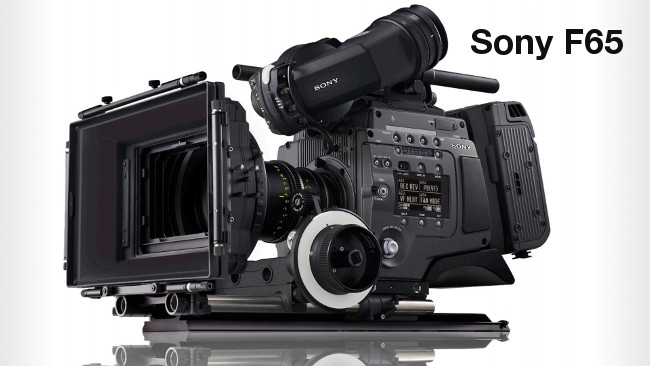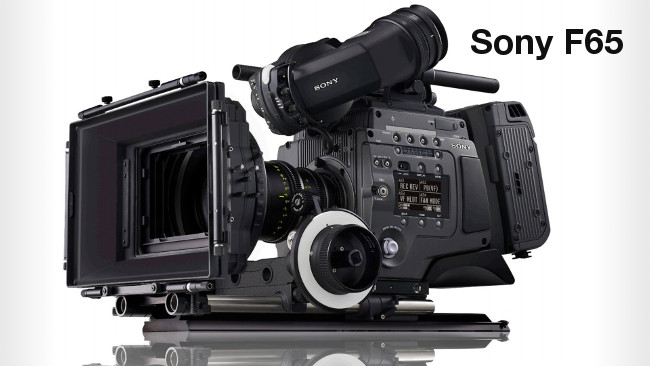
 Sony F65
Sony F65
Today, there's a certain ambiguity about the modern digital photographic tools we're using. This is why, more than ever, we must learn to think critically about them. By Mark Andrew Job.
I come from a strong motion picture background. It is not the purpose of this article to defend motion picture film production, although many of the facts surrounding film have the tendency to do just that. Like many of us who work in this industry, I first became involved with digital film making in the area of post production, via the use of computers, and digital multi-media, as this was the first place the new digital technology took hold.
Decades of digital progress
In the early 1990's, computers became good enough to run efficient video editing applications. The fundamental editing application was Avid's Media Composer. Media Composer, progressed out of George Lucas' Editdroid System. If you remember the early days of computer based video and film editing, there was quite a plethora of truly ground breaking applications which followed and paved the way for the computer to become the essential tool of editing which it is today. After the arrival of Media Composer, there was Adobe Premiere for Windows 3.11, TouchVision Systems Windows 95 based editors, In-Sync's Speed Razor. Digital Processing Systems (DPS) of Markham, Ontario, Canada created the DPS Perception dual stream, realtime, hardware based and hardware accelerated, video editor for the 486 DX 2 66 Mhz PC. The Perception RT (Real Time) dual stream hardware accelerated video editor followed and, finally, the Leitch-Harris Velocity HD dual stream, hardware accelerated video editor running on Windows XP Pro 32 bit. There's also Final Cut Pro for the Mac. I just listed 20 years of Cinema & TV digital editing development. There once was a time when you didn't require a computer to assemble a motion picture or TV show. This time is long passed.
Supremacy of digital?
When I think about how my filmmaking experience began with motion picture film cameras, labs and cutting 16 mm work prints on an old Moviola, I realize we truly have made a quantum technological leap into the digital realm of pixels! It took much longer for the digital realm to overtake the world of analogue videography and cinematography, but it looks like it finally has. I'm not saying emulsion based film making is dead, but it's definitely being handed its hat.
With the new technology, one can sometimes wonder if the image really exists. After all, all we have is 0's and 1's on a hard drive fired off by electrons producing energy. There is a certain ambiguity about the whole process which arises. One of the things I miss the most about the motion picture film days was the certainty about the tools which were available and the format and resolution capabilities they were able to produce. One could confidently predict what his-or-her work would look like on either broadcast television or the Cinema screen if the image acquisition format was motion picture film. It is relevant to say this fact remains true to this day.
However, there is no extant digital moving image acquisition format which truly duplicates the look of 35 mm motion picture film. This inconvenient truth is another reason why there is a certain ambiguity to the use of digital image origination for motion picture production. It is a common practice now to equate the quality of image from digital cinema cameras to 35 mm film origination, as well as to say we are now in the age of the logical progression from motion picture film production, as George Lucas has said many times publicly. There is this unchecked thinking that it is only logical to originate in digital and it's time to discard emulsion altogether as a somewhat inferior, less flexible medium to work in. Lucas has said "film is cumbersome." Critical analysis of the standards and metal language used to compare contemporary digital cinema cameras to motion picture film by the camera manufacturers deserves closer inspection. Taking a more critical view is especially applicable when your own pair of eyes seem to tell you a different story than what the numbers and measurements postulated by manufacturers seem to be saying.
Debunking sensor claims
The first fundamental point of critical examination needs to be made in reference to digital cinema camera manufacturers stating their image sensors are equal in size to the Super 35mm film aperture used by Hollywood filmmakers, thus implying some sort of image quality 'equivalence' by stating an area size equivalence in their comparison of motion picture film aperture and digital sensor size. This claim is most misleading, since there is nothing "super" about the Super 35mm motion picture format in the first place.
Super 35 was and still is a very controversial format among many famous cinematographers the world over. The main advantage to Super 35 is the fact you can shoot to release in an anamorphic four and a half perf projection format without having to use anamorphic lenses, which are slower and considered less sharp than their standard spherical counterparts. Secondly, since the introduction of digital intermediates in the post production process, it becomes possible to shoot with film cameras modified to a 3 perf pull down, instead of the standard four perf pull down, thus an emulsion savings of 1/3 the amount of stock is achieved, while being able to scan a 2:39 to 1 aspect ratio digitally by over-scanning right to the edges of the film perforations. A 2.39:1 aspect ratio allows the studios to repurpose the image to HDTV 16:, film anamorphic 2:40, 2:35 scope prints or the now standard digital widescreen cinema projection. Most cinematographers will tell you this is a terrible idea, preferring to acquire the image in four and a half perf anamorphic (Scope) motion picture film format, due to the greatly increased negative area behind the lens of approximately 50 % as compared to "Super 35."
Dynamic range chicanery
Another point of critical examination needs to be made in the area of the greatly misunderstood measurements of dynamic range in motion picture emulsion versus digital cinema cameras. Welcome to the single greatest point of ambiguity and downright confusion in regard to our understanding of contemporary digital cinematography!
Part of my background in our industry is my experience working as a motion picture laboratory technician. Any laboratory technician will tell you 35mm motion picture negative emulsion does not have 15 stops of exposure latitude. 35mm film is closer to 19 stops of exposure latitude. The wider 65mm motion picture negative has a slightly increased exposure latitude of 22 stops, due to the fact Eastman coats the silver halide and photographic dyes in thicker layers than it does in the manufacture of standard 35mm motion picture film. Eastman Type II 65mm motion picture negative is 1.5mil in thickness, while 35mm emulsion is 0.75mil in thickness.
What are the digital manufacturers saying when they claim their digital cameras have an exposure latitude equal to film @ 15 stops? Obfuscation! It's fudging the numbers in order to sell a product. So, when we talk about digital cinematography being the logical progression in cinema production technology, then we must think critically and realize we are not also claiming it to be equal to or superior to emulsion based cinematography! Any such claims are frankly salesman's bluster at this point. Will we get to the point when digital cinematography is truly equal or superior to emulsion based film making? Yes, I believe we will, but make no mistake, we still are not quite there at this point in time.
Case Study: Sony F65
This whole topic can best be summed up in one product: the Sony F65 digital cinema camera. It's no accident Sony chose to name its digital Cine Alta camera the "F65." Can any of you readers guess what was being implied by naming such a camera intended for digital cinema production thus? If ever there was a digital cinematography product which screams "ambiguity" more, then I don't know it ! The ideas behind this camera's development were not meant to be ambiguous, but the results of this camera's image are.
It's a beautiful camera, however. The Sony F65 has a wonderful (4K) image. The F65 is supposed to be an 8K camera and has a sensor thus, but to date Sony has not enabled the camera to process a full 8K RAW image signal and record it.
We stand at the threshold of the new era. I shoot in 5 perf 65 mm motion picture emulsion like Ultra Panavision 70 MM and walk out of the lab with a 65 mm master negative under my arm. I shoot with the Sony F65 and walk out with what exactly - a disc? A hard drive with all my source picture data on it? A holographic drive able to contain enough capacity to hold two hours of 8K RAW image data on it? How do we wrangle this much data?
It needs to be clearly stated that even feature film productions, which are originated digitally, are transferred to the 5 perf 65mm format and these serve as the master duping negatives, which are placed in the studio's film vault as a permanent archive. Allow yourself to think critically about the new digital mediums and understand there is no archival method superior to a roll of motion picture film negative to last at least the next 100 years. The issue of archiving huge masses of digital information only becomes exacerbated by the ever-increasing image resolution now obtainable by digital cinematographic formats. There needs to be a great deal more research made on both lossless compression codecs, as well as recording media to obtain a practical overall solution.
Personally, I would like to see a company like Canon Camera come out with an 8K digital cinema EOS RAW camera with a sensor equal to Hollywood Scope aperture using anamorphic pixels and digitally unsqueezing the image upon play-out! An exposure latitude of not less than a full 15 stops would be good with 19 stops being desirable. Until then, let us be good artists. A good artist knows the limits and abilities of the tools in their toolbox and takes a critical view of their use.
Tags: Technology


Comments